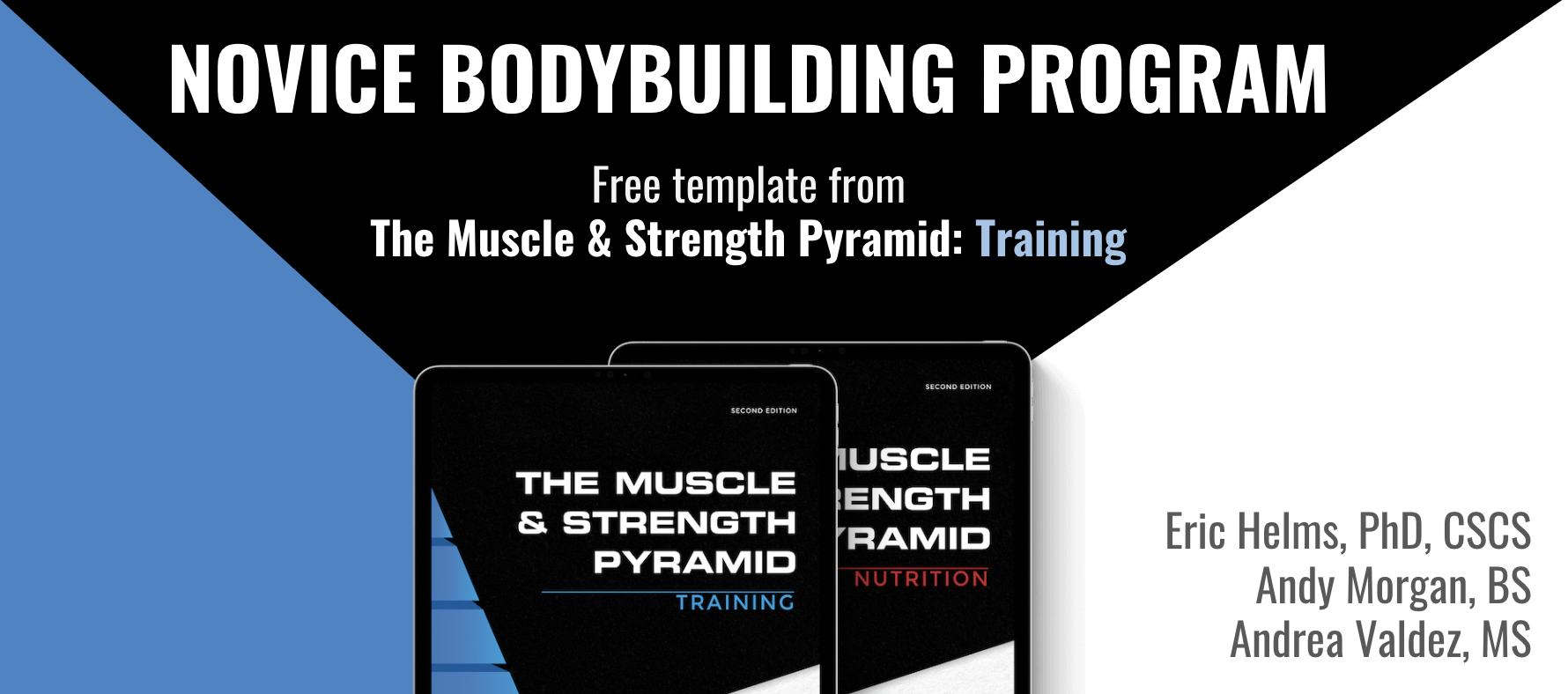Novice Bodybuilding Program (by Eric Helms)
4-day a week program based on the principles from the book Muscle & Strength Pyramid: Training
PROGRAM DESCRIPTION
The Novice Bodybuilding Program is a four-day a week program based on the principles from the Muscle and Strength Pyramid: Training book by Dr. Eric Helms, Andy Morgan, and Andrea Valdez. We highly recommend reading the book to learn evidence-based training and nutrition.
This beginner bodybuilding program has exercises to ensure all muscle groups are adequately trained to help you build a well rounded physique. There are two ‘strength’ days and two ‘volume’ days. Strength development complements the accumulation of training volume and aids hypertrophy.
Read below for full program guidelines.
General guidelines
Spread your workouts out across the week and try to have no more than two sessions back to back. This is better for recovery.
Rest for ~2-3 minutes for the main exercises; ~90 seconds for others.
Spread your workouts out across the week and try to have no more than two sessions back to back.
%1RM = % of 1-rep maximum. It is a guideline for how much you should load the bar the first time you start the program (only). If you don’t know this, just use an RPE of 8.
1st Set RPE = a guideline for how many reps you should stop short of failure for your first set. 8 means to stop when you could do 2 more reps before failing. This determines how much load you should put on the bar.
So, as you get stronger, the same load will feel lighter (a lower RPE) and you can increase the weight. The purpose of this is to help you manage fatigue.
Progression guidlines
After the first session, just add weight in steady increments each time. (This is where ‘linear’ in linear progression comes from.)
For the heavy full and lower body compound movements (e.g., squats and deadlifts) increase 10 lbs (~5 kg) from last week, assuming you can do so with good form. For other exercises that work less overall musculature, (e.g., the bench press, overhead presses, rows, and any isolation exercises) you’ll want to progress in 5 lb (~2.5 kg) or 2.5 lb increments.
Example Novice Progression using 5x5:
Week 1: Load 135 lbs, reps 5,5,5,5,5 (25) => add load next time
Week 2: Load 145 lbs, reps 5,5,5,5,5 (25) => add load next time
Week 3: Load 155 lbs, reps 5,5,5,5,3 (23) => same load next time
Week 4: Load 155 lbs, reps 5,5,5,5,5 (25) => add load next time
Week 5: Load 165 lbs, reps 5,5,5,5,5 (25) => add load next time
What if you stall?
Reduce the load by 10% if you fail to achieve your target reps in two consecutive workouts. The next workout, return to the weight you were unable to complete the target repetitions with and you will more than likely succeed. This is a very simple method of “deloading.” This is a strategy that allows built-up fatigue from weeks of training to dissipate, which in turn lets us continue progressing. There is no need to set this at specific time intervals for novice progression, but it will become necessary for intermediate progression.
PROGRAM OVERVIEW
- LevelBeginner, Novice
- GoalBodybuilding, Powerbuilding
- EquipmentFull Gym
- Program Length12 weeks
- Days Per Week4 days
- Recommended DaysMon, Wed, Fri, Sat
- Time Per Workout60 minutes
ON THE BOOSTCAMP APP FOR FREE
ON THE BOOSTCAMP APP FOR FREE

